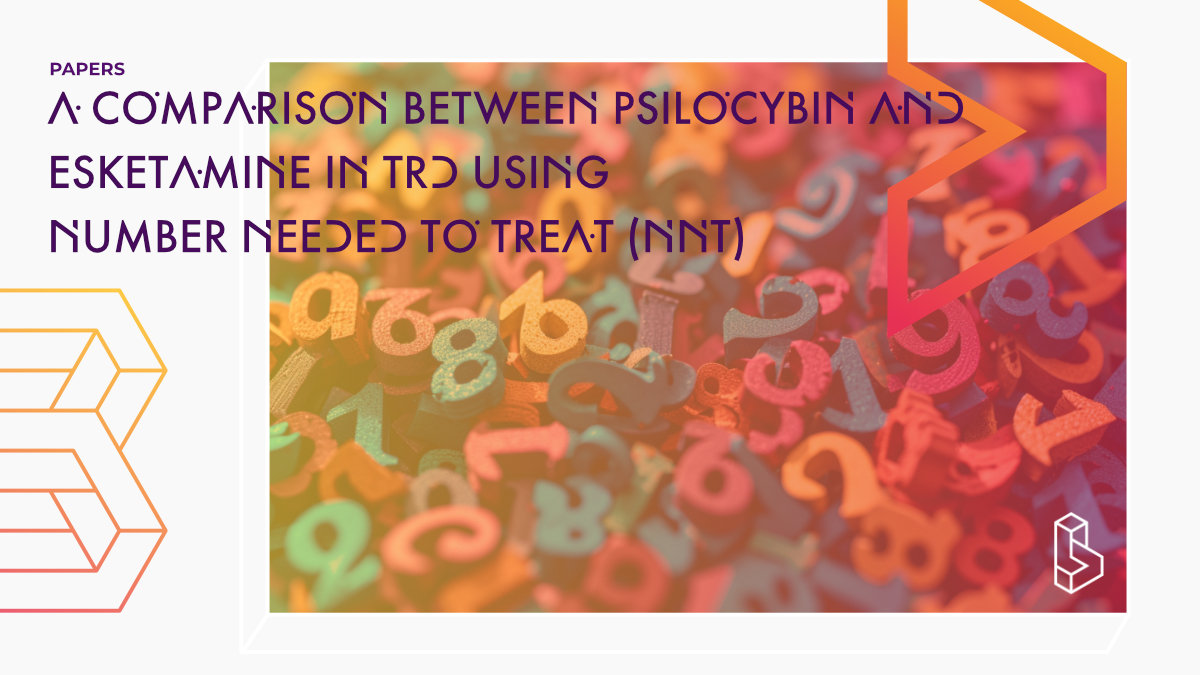This systematic review (s=5) of randomized controlled trials (RCTs) compares oral psilocybin (25mg) and intranasal esketamine (56-84mg) with an oral antidepressant in adults with depression (TRD). The review showed significant depressive symptom reduction with psilocybin (Number Needed to Treat; NNT=5) and esketamine (NNT=7). Psilocybin has a Number Needed to Harm (NNH) of 5 for nausea, while esketamine induces mild side effects (NNH<10).
Abstract of A comparison between psilocybin and esketamine in treatment-resistant depression using number needed to treat (NNT): A systematic review
“Background: Inadequate outcomes with monoamine-based treatments in depressive disorders are common and provide the impetus for mechanistically-novel treatments. Esketamine is a proven treatment recently approved for adults with Treatment-Resistant Depression (TRD) while psilocybin is an investigational treatment. Translation of the clinical meaningfulness for these foregoing agents in adults with TRD is required. Herein we evaluate the Number Needed to Treat (NNT) and Harm (NNH) of esketamine and psilocybin in adults with TRD.
Methods: We conducted a systematic review of randomized controlled trials, comparing the clinical efficacy of oral psilocybin to the co-commencement of intranasal esketamine with an oral antidepressant in adults with TRD.
Results: 25 mg psilocybin had a significant reduction in depressive symptoms at 21-days post-dose, the NNT was 5 [95 % CI = 3.1, 18.5]. Psilocybin-induced nausea had a significant NNH = 5. Fixed-dosed esketamine at 56 mg and 84 mg had a significant effect at 28-days post-dose, (NNT of 7 [95 % CI56mg = 3.5, 46.7], [95 % CI84mg = 3.6, 142.2]). Esketamine-induced headache, nausea, dizziness, and dissociation had NNHs <10.
Limitations: The preliminary results may only reflect a small portion of the patient population. These results require replication and longer term studies investigating maintenance therapy.
Conclusion: Relatively few pharmacologic agents are proven safe and effective in adults with TRD. NNT estimates for investigational psilocybin and esketamine in TRD indicate clinical meaningfulness. The NNH profile for both aforementioned agents is clinically acceptable. Our results underscore the clinical relevance of these treatment options in adults with TRD.”
Authors: Sabrina Wong, Angela T.H. Kwan, Kayla M. Teopiz, Gia Han Le, Shakila Meshkat, Roger Ho, Giacomo d’Andrea, Bing Cao, Joshua D. Di Vincenzo, Joshua D. Rosenblat & Roger S. McIntyre
Summary of A comparison between psilocybin and esketamine in treatment-resistant depression using number needed to treat (NNT): A systematic review
Introduction
MDD is a mood disorder that affects approximately 3.8% of the world’s population. While treatment options may include psychotherapy, medication, or neurostimulation, the most effective treatment scheme follows the guidelines from the Sequenced Treatment Alternatives to Relieve Depression (STAR*D) trial.
Psychedelics are proposed as treatments for TRD by acting through different mechanisms of action. Esketamine, the first glutamate-based antidepressant approved for adults living with TRD, is a non-competitive antagonist of the N-Methyl-D-Aspartate (NMDA) glutamate receptors. Psilocybin, a substituted tryptamine, is currently an investigational agent for TRD, and acts as an agonist of the 5-HT2A serotonergic receptors and secondarily on the 5-HT2B and 5-HT2C receptors. Its antidepressant efficacy converges on rapid activation of synaptogenesis, cellular excitability, and second messenger pathways responses.
Find this paper
https://doi.org/10.1016/j.jad.2024.01.142
Paywall | Google Scholar | Backup | 🕊
Cite this paper (APA)
Wong, S., Kwan, A. T., Teopiz, K. M., Le, G. H., Meshkat, S., Ho, R., ... & McIntyre, R. S. (2024). A comparison between psilocybin and esketamine in treatment-resistant depression using number needed to treat (NNT): A systematic review. Journal of Affective Disorders.
Study details
Compounds studied
Ketamine
Psilocybin
Topics studied
Treatment-Resistant Depression
Depression
Economics
Study characteristics
Literature Review
Randomized
Participants
1065
Humans

